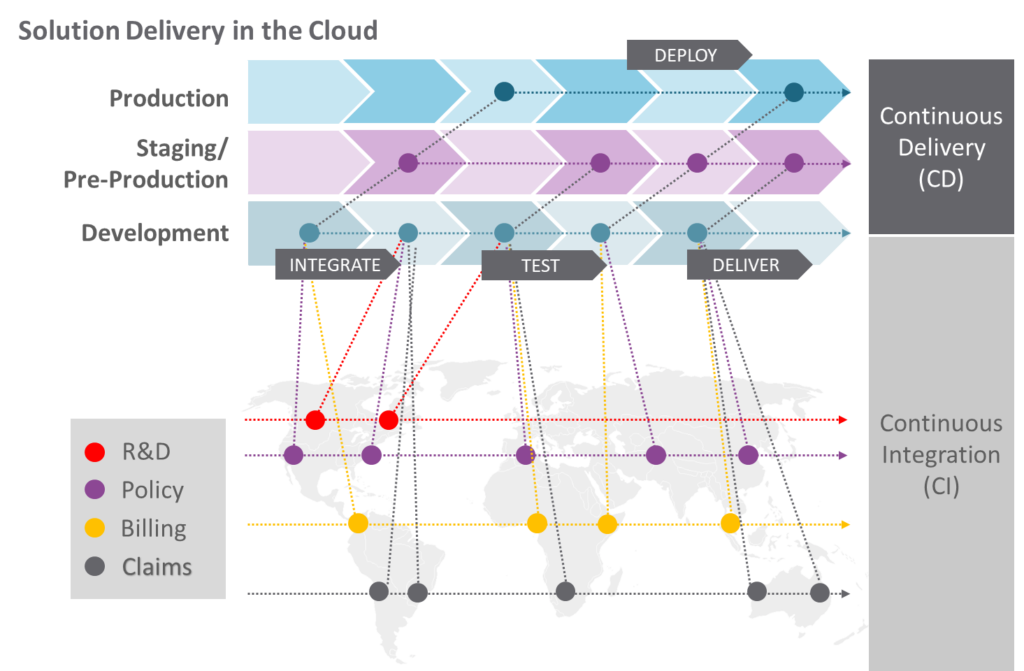DevOps provides agility and less disruption from transformation and upgrades
Speed, time to market, and innovation are taking hold in the insurance industry, but it wasn’t always that way. Just five years ago, the response to putting core applications in the cloud was a resounding “No way, not here.” Just three years ago, suggesting an agile implementation might be meet with a Heisman-like, fending-off-a-tackle pose. More recently, conversations around microservices architectures were met with similar stand-offish stances. But DevOps is the glue that ties all these approaches together and is accelerating insurers acceptance of cloud, Agile and microservices to deliver the speed-to-market, and test-and-learn capabilities that carriers are now seeking.
Historically, the bane of the prepackaged software industry has been big bang upgrades. It was common that the implementation of the original software took eighteen months, and sometimes as much as three years, and when the upgrade happens—a few years later—it’s just as big as the original implementation itself. Fortunately, those days are gone.
Today we can expect core insurance system implementations are averaging six months to twelve months depending on complexity, and that’s coming down. And updates to major capabilities can now happen every quarter. Anyone buying core software today should endeavor to understand the vendor’s upgrade and DevOps approach as this is where the game-changing magic is taking place.
The engine of automation
Just doing cloud, just doing Agile, just doing microservices without DevOps is not going to get you to where you need to be. IT operations then become the bottleneck. Development and IT operations have to work together to take very frequent small changes through to production regularly. DevOps—the merging of software development and IT operations—is the engine of automation. Automation is the output of DevOps.
Developing and testing are processes that are repetitive tasks that involve highly skilled people but are prone to error. DevOps allows for higher quality and faster delivery. Recent cross-industry studies indicate that 3x cost savings are possible when you go from a traditional method of building and deploying software to this new model. Said another way, for every dollar spent on a project with the traditional approach, the same cost in a DevOps model is $0.34.
But it doesn’t happen overnight. What EIS plans for our customers is that once they engage and embrace a DevOps model, that fully leverages a continuous development and delivery (CI/CD) process, they’ll likely achieve thirty to forty percent savings. As they practice this discipline and get better at it, they will see greater cost efficiency. We have one all-star customer whose goal it is to push a button to upgrade the software, and it won’t matter how often or what time of day they do it, there will be no business disruption. They’re not there yet, but that is what they’re striving towards.
Continuous development and delivery
CI/CD is essential. EIS implemented its CI/CD framework and toolset a few years ago, so it is a mature delivery pipeline practice. You can see it illustrated below. In the Continuous Delivery operation, see the bottom of the illustration, development team members, and in our case, they are all over the globe, are integrating their work frequently. They’re saving a lot of changes every day. What is exceptional, however, is that when they save those changes, a full build takes place. Everything is tested, even regression tested, all the way. The result is a verified and automated build ready for production.

CI/CD in the cloud enables global parallel development and testing, to provide frequent and faster delivery of user capabilities of a higher quality.
At the top part of the illustration is Continuous Delivery. Importantly, as a carrier, you get to choose when you’re going to take-up and implement those changes into production. EIS releases software to production every quarter. We do about nineteen releases a year. We find our customers taking those releases to production on average every quarter.
We’ve had customers start with an annual update, move to six months, then do production updates every quarter as they gained proficiency with the CI/CD model.
CI/CD is not just about speed to market, however. It is also about improved quality. One of our customers who implemented the model experienced sixty percent fewer production defects and a seventy-five percent reduction in full regression testing time.
Reducing business disruption
When some of our customers think about their upgrade process, they think of the app store model. When you upgrade the apps on your phone, you are not doing it every eighteen months or every two years; you are doing it every few weeks or every few months, which reduces the costs of business disruption. When your business users are taking small, incremental changes that they can manage they find them easy to learn–a few changes at a time. When you had to upgrade every two to five years, users essentially had to re-learn the system.
The bottom line is that there is much less business disruption, and much less IT and operational disruption in the new software delivery model. And the coup de grace is the elimination of the “big bang” upgrade. From a business perspective, it truly helps insurers respond to changes in the dynamic business environment that we are moving into. But it requires cloud, Agile, and DevOps all working in tandem.
Anthony Grosso is vice president, Product Marketing & Industry Strategy at EIS.




